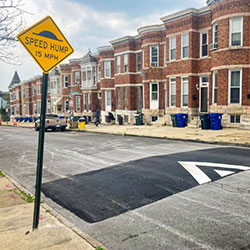Speed bumps are raised sections of road designed to slow down vehicles. They are typically 3 to 6 inches high and extend across the width of the road or parking lot. Speed bumps create an uncomfortable sensation for drivers if taken at high speeds, effectively encouraging them to slow down. They are commonly installed in areas where controlling vehicle speed is crucial to protect pedestrians and reduce accidents.
The Impact of Speed Bumps on Road Safety in Residential and Commercial Zones
Speed bumps are a common feature in parking lots, residential streets, and commercial areas, but have you ever wondered why they’re so prevalent? Their role goes beyond merely slowing down traffic. Let’s explore how speed bumps contribute to road safety and why they’re an essential tool for traffic management.The Benefits of Speed Bumps
1. Speed Reduction: The primary function of speed bumps is to reduce vehicle speed, particularly in areas where pedestrians are present. By forcing drivers to slow down, speed bumps help prevent accidents and enhance the overall safety of the area. 2. Pedestrian Safety: In residential neighborhoods, school zones, and commercial areas, speed bumps play a crucial role in protecting pedestrians. By reducing vehicle speed, they allow drivers more time to react to crossing pedestrians, thus preventing accidents. 3. Traffic Calming: Speed bumps are a highly effective traffic calming measure. They help manage traffic flow, discourage reckless driving, and create a safer environment for both drivers and pedestrians. 4. Low Maintenance Costs: Once installed, speed bumps require minimal maintenance. They are a cost-effective solution for long-term traffic management, making them a popular choice for municipalities and property managers. 5. Durability: Made from durable materials such as asphalt, concrete, or rubber, speed bumps are designed to withstand heavy traffic and harsh weather conditions. This durability ensures they remain effective for many years.When selecting speed bumps for your area, consider the following:
- Material: Rubber speed bumps are flexible and easy to install, making them ideal for temporary setups. Asphalt and concrete speed bumps are more permanent and suited for high-traffic areas.
- Height and Length: The height and length of the speed bump should match the speed reduction goals and the specific environment. Taller speed bumps slow vehicles more drastically, while longer ones offer a smoother ride.
- Visibility: For maximum effectiveness, choose speed bumps with reflective markings or bright colors that enhance visibility, especially at night or in low-light conditions.
- Placement: Speed bumps should be strategically placed in high-risk areas, such as near crosswalks, school zones, or entrances to parking lots, where speed reduction is critical.

